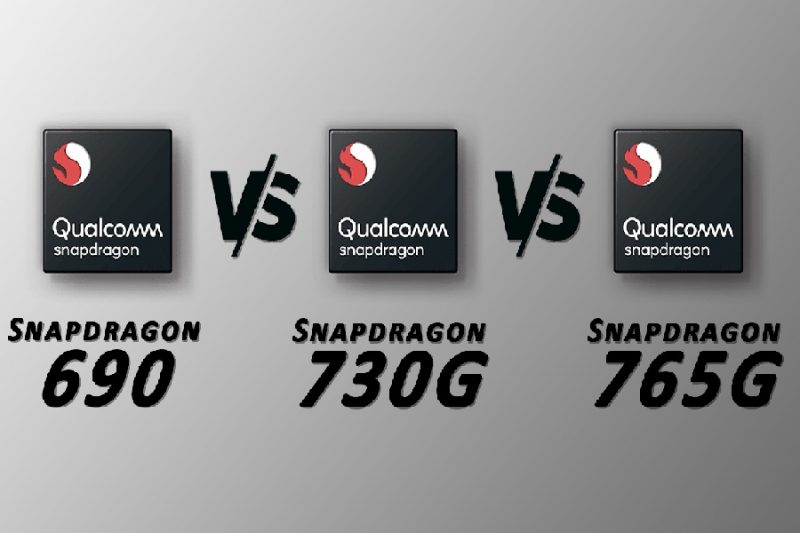The Snapdragon 6 series was waiting for a new member ever since the launch of Snapdragon 675. And now the wait is over as the new Snapdragon 690 5G SoC has been revealed by Qualcomm today. It lies in the Snapdragon 6 series and is a successor of SD 675. But there are a lot of things that makes the Snapdragon 690 SoC a completely new SoC altogether. Its specifications are similar to what some of the popular Snapdragon 7 series SoC provides along with a flagship-level CPU microarchitecture. If you are getting confused about what I am trying to say.
Then have some patience as in this article I am going to have a deep look at the Snapdragon 690 SoC. And I will be comparing it with two of the most popular Snapdragon 7 series SoC’s i.e. the Snapdragon 730G and 765G. The Snapdragon 765G was the only affordable offering from the company for 5G connectivity. But the Snapdragon 690 has stolen the crown of the most affordable 5G chipset from Qualcomm. Hence, it is really very important to compare both of these. Additionally, the performance of the Snapdragon 690 is very close to the Snapdragon 730G. And hence, I have also included the SD 730G SoC as well. Without any further ado, let’s get started!
Recommended: Snapdragon 765G vs 730G vs MediaTek Helio G90T – Antutu-Geekbench Benchmark Scores
Snapdragon 690 vs 730G vs 765G Comparison
CPU & Manufacturing Process
The Snapdragon 730G and 690 have been made over the TSMC’s 8nm LPP fabrication. On the other hand, the Snapdragon 765G has a bit advanced lithography of 7nm which is a EUV-based fabrication from Samsung. The EUV fabrication and more narrow architecture make the Snapdragon 765G, an SoC with better efficiency.
Coming to the cores, the Snapdragon 690 and 730G uses a dual cluster design with a combination of 2+6 performance and efficiency cores. The performance cores of SD 690 are based on the Cortex-A77 microarchitecture at 2.0GHz and efficiency cores on Cortex-A55 at 1.7GHz. The performance and efficiency cores of SD 730G are Cortex-A76 and A55 at 2.2GHz and 1.8GHz respectively.
On shifting to the Snapdragon 765G, there is a tri-cluster design having a distribution of 1+1+7. There is one prime Cortex-A76 core at 2.4GHz, one mid-performing Cortex-A76 core at 2.2GHz, and six Cortex-A55 efficiency cores at 1.8GHz. The use of Cortex-A77 microarchitecture makes the Snapdragon 690 to have a CPU performance uplift of 20% from its predecessor, the SD 675. But this is not enough to outperform the Snapdragon 730G and 765G. Both the SoC features more clock speeds and hence are a bit better.
GPU & Gaming
The Snapdragon 690 has been upgraded to the new Adreno 619L GPU. Based on this GPU, Qualcomm claims 60% better graphical performance from Adreno 612 GPU of Snapdragon 675. The Snapdragon 730G has the Adreno 618 GPU which, as per the naming, places it below the Adreno 619L of SD 690. But the Snapdragon 730G is a gaming SoC and its GPU has been overclocked to 82MHz and hence there are fewer chances for Snapdragon 690 to outperform Snapdragon 730G in GPU performance.
The Snapdragon 765G has the Adreno 620 GPU which is 20% faster than the Adreno 618 GPU, whose overclocked version is available in the Snapdragon 730G. Additionally, the “G” version gets the partial support for the Qualcomm Elite Gaming technology which is not available in the Snapdragon 690.
Also Read: Snapdragon 720G vs 730G vs 765G vs MediaTek Helio G90T – Antutu-Geekbench Benchmark Scores
AnTuTu-Geekbench Benchmark Scores
AnTuTu Benchmarks
The Snapdragon 765G has an average AnTuTu score of about 3,00,000 which is a pretty good score in comparison to the Snapdragon 730G’s average score of 2,55,000. Snapdragon 690 being a new chip, we don’t have yet available Antutu benchmark scores.

Geekbench Benchmarks
The Geekbench scores of the SoC are very close between the Snapdragon 765G and 730G. The Singe-Core score of SD 765G and 730G are 467 and 546 respectively. And the Multi-Core scores are 1,757 and 1,726. Similar to Antutu, Snapdragon 690 Geekbench scores are unavailable. We will be updating the list as soon as we get Snapdragon 690 benchmark scores.

Artificial Intelligence
The new Snapdragon 690 has been loaded with the new 5th generation AI Engine of Qualcomm which has been coupled with the Hexagon 692 DSP. This DSP is the same that has been used in the Snapdragon 720G but is not capable of outperforming the Snapdragon 730G.
The Snapdragon 730G has Hexagon 688 DSP with dedicated Neural SDK and Voice Assistant chip for better AI and machine learning. There is a 4th generation AI Engine in the Snapdragon 730G. Lastly, the Snapdragon 765G is working with the new Hexagon 696 DSP and has been coupled with the 5th generation AI Engine from Qualcomm and has the best AI and Machine learning hardware among all the thee Snapdragon SoC of this comparison.
ISP & Camera
In terms of the Image Signal Processor, the Snapdragon 690 lies in between SD 730G and 765G SoC. There is the Spectra 355L ISP in the Snapdragon 690 which is a bin-down version of the Spectra 350 ISP, used in the Snapdragon 765G. Whereas the Snapdragon 730G has the Spectra 350 ISP.
The SD 690 supports 48MP of a single camera with up to 192MP snapshot support. For dual-camera it has 32+16MP support. It has 10-bit capture and display pipeline which makes the SoC have support for 4K HDR capture and display support.
The Snapdragon 730Ghas support for 36MP single camera and 22+22MP Dual camera. It can shoot 4K videos at 30fps. And have support for a Quad HD+ HDR10 display. But there is no default support for high refresh rates in the display. Lastly, the Snapdragon 765G also has the same 36MP single camera and 22+22MP dual camera support. But it also has support for shooting 4K HDR videos along with HDR display of up to Quad HD+.
Connectivity
In this section, the Snapdragon 690 comes out to be the best value for money deal. It has the Snapdragon X51 5G modem which is a multi-mode 5G modem and works on Sub-6 5G connectivity. It has 4G/LTE speeds of 1.2 Mbps in downlink and 210Mbps in the uplink. And for the Sub-6 5G connectivity it has speeds of 2.5 Gbps and 660Mbps in Downlink and Uplink.
Coming to the Snapdragon 765G, it has the Snapdragon X52 5G Modem which is a bit better than the X51 modem. It has 5G speeds of 3.7 Gbps in downlink and 1.6 Gbps in the uplink. Along with Sub-6 5G, the SD 765G also has the mmWave 5G connectivity which is not available in the Snapdragon 690.
Lastly, the Snapdragon 730G. It is a 4G SoC and hence is not that impressive in terms of connectivity. It has the Snapdragon X15 LTE modem with 800 Mbps downlink and 150 Mbps uplink speeds. The Snapdragon 690 also has the NavIC support which is not available in the SD 730G and 765G. However, the Wi-Fi 6 connectivity is available in all the SoC.
Read More: Snapdragon 855 vs 845 vs Snapdragon 730 vs 730G – Antutu-Geekbench Benchmark Scores
Conclusion
Concluding the things up. The newly launched Snapdragon 690 has a lot of potentials. Its specifications are a lot more promising along with a promise of proving the best 5G connectivity in a budget. Its X51 modem is a very good call from Qualcomm to reduce the gap between 5G connectivity and low budget.
Along with that, the Snapdragon 690’s Cortex-A77 cores are also phenomenal as these cores are available only in the Snapdragon 865 in the Snapdragon family. Other minor improvements in GPU, DSP, and ISP are also making this Snapdragon 6 series SoC more like a Snapdragon 7 series SoC.
I would definitely choose the Snapdragon 690 over the 730G if the smartphone with the SD 690 is offering 5G. But Snapdragon 730G still comes handy for Asian markets, where 5G is still far away. But when it comes to the Snapdragon 765G, the Snapdragon 690 has more to cover. The Snapdragon 765G is still an overall better package for a reasonable price.


